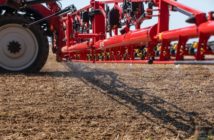Quick action, and careful product choice at T3 are the key to protecting yield and grain quality against Fusarium ear diseases, their associated mycotoxin risk, as well the increasing significance of Microdochium Spp says Dr Paul Fogg, Senior Crop Team Leader at Adama.
Weather conditions at flowering are decisive with warm, wet weather helping infections to build and spread. “As soon as disease is present, yield is being lost, and once fusarium infection has occurred symptoms can increase quickly,” says Dr Fogg.
“T3 is all about keeping the plant clean, reducing infection, and ensuring yield and quality through to harvest. More than ever the T3 spray is viewed as an essential management tool to protect the grower’s investment in time, effort, nutrition, seed and chemistry.”
T3 spray – essential management tool
A robust dose (at least half rate) of triazole spray timed at mid-flower will provide good activity against all Fusarium species. However, when it comes to protecting against Microdochium Spp., most triazoles have struggled in the past. Recent FERA laboratory trials demonstrated that prochloraz + tebuconazole (sold as Orius® P) offered outstanding efficacy against both the main mycotoxin causing species F.graminearum, F.culmorium and both Microdochium species.
Cost-effective
“It is the prochloraz inclusion that appears to add something against both Microdochium species,” says Dr Fogg, “and of the 13 products tested Orius® P was the most active, – almost 10 times more active than prothioconazole making it a very cost-effective product at T3”.
Although laboratory results are not directly related to field activity this does give an idea of likely performance, comments Dr Fogg. “Subsequent field trials have confirmed that Orius® P offers a strong alternative to current standard approaches”.
“The incidence of fusarium has increased over recent years as cropping and husbandry techniques have changed,” says Dr Fogg, “but produced in the field there is little that can be done about removing mycotoxins from wheat once the crop is harvested.
“With so much value in your crop, a robust dose 1l/ha (Orius® P) at early to mid flowering (GS61+) to stop infection from gaining ground will protect your investment. Prevention is always better than cure.”



